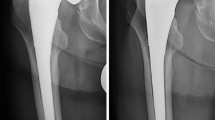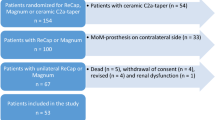Abstract
Background
Many factors affect the blood metal ion levels after metal-on-metal (MOM) hip arthroplasty. The main surgically adjustable variable is the amount of coverage of the head provided by the cup which is a function of the inclination and version angles. However, most studies have used plain radiographs which have questionable precision and accuracy, particularly for version and large diameter metal heads; further, these studies do not simultaneously assess version and inclination. Thus the relationship between version and blood metal ions levels has not been resolved.
Questions/purposes
We determined whether cup inclination and version influence blood metal ion levels while adjusting for age at assessment, gender, body mass index, horizontal femoral offset, head size, manufacturer hip type, and Oxford hip score.
Patients and Methods
We prospectively followed 100 individuals (51 females, 49 males) with unilateral MOM hip resurfacing who underwent clinical assessment, CT scanning, and blood metal ion measurement. Multiple regression analysis was used to determine which variables were predictors of blood metal ion levels and to model the effect of these variables.
Results
Only cup inclination, version angles, and gender influenced blood cobalt or chromium levels. Cobalt and chromium levels positively correlated with inclination angle and negatively correlated with version angle. The effect of changes in version angle was less than for inclination angle. Based on our observations, we developed a formula to predict the effect of these parameters on metal ion levels.
Conclusions
Our data suggest insufficient cup version can cause high blood metal ions after MOM hip arthroplasty. We were unable to show that excessive version caused high levels.
Level of Evidence
Level II, prognostic study. See Guidelines for Authors for a complete description of levels of evidence.




Similar content being viewed by others
References
Angadji A, Royle M, Collins SN, Shelton JC. Influence of cup orientation on the wear performance of metal-on-metal hip replacements. Proc Inst Mech Eng H. 2009;223:449–457.
Antoniou J, Zukor DJ, Mwale F, Minarik W, Petit A, Huk OL. Metal ion levels in the blood of patients after hip resurfacing: a comparison between twenty-eight and thirty-six-millimeter-head metal-on-metal prostheses. J Bone Joint Surg Am. 2008;90(suppl 3):142–148.
Back DL, Young DA, Shimmin AJ. How do serum cobalt and chromium levels change after metal-on-metal hip resurfacing? Clin Orthop Relat Res. 2005;438:177–181.
Bowsher JG, Hussain A, Williams PA, Shelton JC. Metal-on-metal hip simulator study of increased wear particle surface area due to ‘severe’ patient activity. Proc Inst Mech Eng [H]. 2006;220:279–287.
Bozic KJ, Kurtz S, Lau E, Ong K, Chiu V, Vail TP, Rubash HE, Berry DJ. The epidemiology of bearing surface usage in total hip arthroplasty in the United States. J Bone Joint Surg Am. 2009;91:1614–1620.
Clarke MT, Lee PT, Arora A, Villar RN. Levels of metal ions after small- and large-diameter metal-on-metal hip arthroplasty. J Bone Joint Surg Br. 2003;85:913–917.
Dandachli W, Islam SU, Liu M, Richards R, Hall-Craggs M, Witt J. Three-dimensional CT analysis to determine acetabular retroversion and the implications for the management of femoro-acetabular impingement. J Bone Joint Surg Br. 2009;91:1031–1036.
Daniel J, Ziaee H, Pradhan C, Pynsent PB, McMinn DJ. Blood and urine metal ion levels in young and active patients after Birmingham hip resurfacing arthroplasty: four-year results of a prospective longitudinal study. J Bone Joint Surg Br. 2007;89:169–173.
Dawson J, Fitzpatrick R, Carr A, Murray D. Questionnaire on the perceptions of patients about total hip replacement. J Bone Joint Surg Br. 1996;78:185–190.
De Haan R, Campbell P, Reid S, Skipor AK, De Smet K. Metal ion levels in a triathlete with a metal-on-metal resurfacing arthroplasty of the hip. J Bone Joint Surg Br. 2007;89:538–541.
De Haan R, Campbell PA, Su EP, De Smet KA. Revision of metal-on-metal resurfacing arthroplasty of the hip: the influence of malpositioning of the components. J Bone Joint Surg Br. 2008;90:1158–1163.
De Haan R, Pattyn C, Gill HS, Murray DW, Campbell PA, De Smet K. Correlation between inclination of the acetabular component and metal ion levels in metal-on-metal hip resurfacing replacement. J Bone Joint Surg Br. 2008;90:1291–1297.
Desy NM, Bergeron SG, Petit A, Huk OL, Antoniou J. Surgical variables influence metal ion levels after hip resurfacing. Clin Orthop Relat Res. 2010 Oct 23. [Epub ahead of print].
Dowson D, Hardaker C, Flett M, Isaac GH. A hip joint simulator study of the performance of metal-on-metal joints: Part II: design. J Arthroplasty 2004;19:124–130.
Dunstan E, Sanghrajka AP, Tilley S, Unwin P, Blunn G, Cannon SR, Briggs TW. Metal ion levels after metal-on-metal proximal femoral replacements: a 30-year follow-up. J Bone Joint Surg Br. 2005;87:628–631.
Grover M, Sauve P, Mountney J, Khan T, De Beer J, Higgins B. Metal ion levels after metal-on-metal Ring total hip replacement: a 30-year follow-up study. J Bone Joint Surg Br. 2007;89:586–590.
Grubl A, Weissinger M, Brodner W, Gleiss A, Giurea A, Gruber M, Poll G, Meisinger V, Gottsauner-Wolf F, Kotz R. Serum aluminium and cobalt levels after ceramic-on-ceramic and metal-on-metal total hip replacement. J Bone Joint Surg Br. 2006;88:1003–1005.
Hart AJ, Buddhdev P, Winship P, Faria N, Powell JJ, Skinner JA. Cup inclination angle of greater than 50 degrees increases whole blood concentrations of cobalt and chromium ions after metal-on-metal hip resurfacing. Hip Int. 2008;18:212–219.
Hart AJ, Dandachli W, Schleuter-Brust K, Henckel J, Cobb JP. Large ball metal on metal hips obscure cup angle measurement on plain radiographs. Hip Int. 2009;19:323–329.
Hart AJ, Sabah S, Henckel J, Lewis A, Cobb J, Sampson B, Mitchell A, Skinner JA. The painful metal-on-metal hip resurfacing. J Bone Joint Surg Br. 2009;91:738–744.
Hart AJ, Skinner JA, Winship P, Faria N, Kulinskaya E, Webster D, Muirhead-Allwood S, Aldam CH, Anwar H, Powell JJ. Circulating levels of cobalt and chromium from metal-on-metal hip replacement are associated with CD8+ T-cell lymphopenia. J Bone Joint Surg Br. 2009;91:835–842.
Heisel C, Silva M, Skipor AK, Jacobs JJ, Schmalzried TP. The relationship between activity and ions in patients with metal-on-metal bearing hip prostheses. J Bone Joint Surg Am. 2005;87:781–787.
Henckel J, Richards R, Lozhkin K, Harris S, Baena FM, Barrett AR, Cobb JP. Very low-dose computed tomography for planning and outcome measurement in knee replacement. The imperial knee protocol. J Bone Joint Surg Br. 2006;88:1513–1518.
Jacobs JJ, Skipor AK, Patterson LM, Hallab NJ, Paprosky WG, Black J, Galante JO. Metal release in patients who have had a primary total hip arthroplasty: a prospective, controlled, longitudinal study. J Bone Joint Surg Am. 1998;80:1447–1458.
Kalteis T, Handel M, Herold T, Perlick L, Paetzel C, Grifka J. Position of the acetabular cup: accuracy of radiographic calculation compared to CT-based measurement. Eur J Radiol. 2006;58:294–300.
Kwon YM, Glyn-Jones S, Simpson DJ, Kamali A, McLardy-Smith P, Gill HS, Murray DW. Analysis of wear of retrieved metal-on-metal hip resurfacing implants revised due to pseudotumours. J Bone Joint Surg Br. 2010;92:356–361.
Langton DJ, Jameson SS, Joyce TJ, Hallab NJ, Natu S, Nargol AV. Early failure of metal-on-metal bearings in hip resurfacing and large-diameter total hip replacement: a consequence of excess wear. J Bone Joint Surg Br. 2010;92:38–46.
Langton DJ, Jameson SS, Joyce TJ, Webb J, Nargol AV. The effect of component size and orientation on the concentrations of metal ions after resurfacing arthroplasty of the hip. J Bone Joint Surg Br. 2008;90:1143–1151.
Langton DJ, Sprowson AP, Joyce TJ, Reed M, Carluke I, Partington P, Nargol AV. Blood metal ion concentrations after hip resurfacing arthroplasty: a comparative study of articular surface replacement and Birmingham Hip Resurfacing arthroplasties. J Bone Joint Surg Br. 2009;91:1287–1295.
Lewinnek GE, Lewis JL, Tarr R, Compere CL, Zimmerman JR. Dislocations after total hip-replacement arthroplasties. J Bone Joint Surg Am. 1978;60:217–220.
Lusty PJ, Watson A, Tuke MA, Walter WL, Walter WK, Zicat B. Wear and acetabular component orientation in third generation alumina-on-alumina ceramic bearings: an analysis of 33 retrievals [corrected]. J Bone Joint Surg Br. 2007;89:1158–1164.
MHRA. Medical Device Alert MDA/2010/033: All metal-on-metal (MOM) hip replacements. Available at: http://www.mhra.gov.uk/Publications/Safetywarnings/MedicalDeviceAlerts/CON079157. Accessed April 29, 2011.
National Joint Registry. 5th Annual report. Available at: www.njrcentre.org.uk . Accessed April 29, 2011.
Pandit H, Glyn-Jones S, McLardy-Smith P, Gundle R, Whitwell D, Gibbons CL, Ostlere S, Athanasou N, Gill HS, Murray DW. Pseudotumours associated with metal-on-metal hip resurfacings. J Bone Joint Surg Br. 2008;90:847–851.
Petrie A. Statistics in orthopaedic papers. J Bone Joint Surg Br. 2006;88:1121–1136.
Sauve P, Mountney J, Khan T, De Beer J, Higgins B, Grover M. Metal ion levels after metal-on-metal Ring total hip replacement: a 30-year follow-up study. J Bone Joint Surg Br. 2007;89:586–590.
Shimmin AJ, Walter WL, Esposito C. The influence of the size of the component on the outcome of resurfacing arthroplasty of the hip: a review of the literature. J Bone Joint Surg Br. 2010;92:469–476.
United States Food and Drug Administration. New Device Approval: Birmingham Hip Resurfacing P040033. May 9, 2006. Available at: http://www.fda.gov/cdrh/mda/docs/p040033.html. Accessed February 24, 2009.
United States Food and Drug Administration. New Device Approval: Cormet Hip Resurfacing P050016. July 3, 2007. Available at: http://www.fda.gov/cdrh/mda/docs/P050016.html. Accessed February 24, 2009.
Vendittoli PA, Ganapathi M, Lavigne M. Blood and urine metal ion levels in young and active patients after Birmingham hip resurfacing arthroplasty. J Bone Joint Surg Br. 2007;89:989.
Vendittoli PA, Mottard S, Roy AG, Dupont C, Lavigne M. Chromium and cobalt ion release following the Durom high carbon content, forged metal-on-metal surface replacement of the hip. J Bone Joint Surg Br. 2007;89:441–448.
Walter WL, O’Toole GC, Walter WK, Ellis A, Zicat BA. Squeaking in ceramic-on-ceramic hips: the importance of acetabular component orientation. J Arthroplasty. 2007;22:496–503.
Acknowledgments
We thank Gwynneth Lloyd for assistance in coordinating the additional investigations for the followup clinics, Prof. Justin Cobb for general support in the hospital for the study, and Prof. Jonathan Powell for assistance in data analysis.
Author information
Authors and Affiliations
Corresponding author
Additional information
The institution of one or more of the authors (AH and JS) has received funding from the British Orthopaedic Association (BOA) through an industry consortium of nine manufacturers: Depuy, Zimmer, Smith & Nephew, Biomet, JRI, Finsbury, Corin, Mathys and Stryker.
Each author certifies that his or her institution approved the human protocol for this investigation, that all investigations were conducted in conformity with ethical principles of research, and that informed consent for participation in the study was obtained.
This work was performed at Imperial College London.
About this article
Cite this article
Hart, A.J., Skinner, J.A., Henckel, J. et al. Insufficient Acetabular Version Increases Blood Metal Ion Levels after Metal-on-metal Hip Resurfacing. Clin Orthop Relat Res 469, 2590–2597 (2011). https://doi.org/10.1007/s11999-011-1930-y
Received:
Accepted:
Published:
Issue Date:
DOI: https://doi.org/10.1007/s11999-011-1930-y




